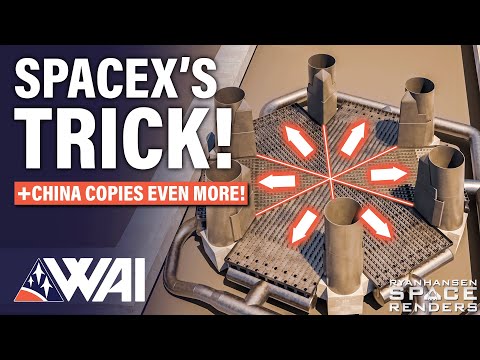Why does SpaceX use new HEAVY equipment to fix the Starship launch mount?

They did what??? My name is Felix, and I’m your host for today’s episode of What about it. Heaps of drilling action at Starbase to prepare for the second orbital flight, Mega Bay 2 develops at a rapid pace, Hubble might get a rescue mission, and Virgin Galactic is making a comeback. Stay tuned, and let’s dive right in! Starship Updates Day and night, engineers at Starbase are working together like little ants to achieve one goal.
Repair the Orbital Launch Mount, to get another rocket off that pad. So far, it’s been looking like everything is going ahead of the planned schedule… In the previous episode, I showed you the surge of hardware that Starbase saw in recent days. We’ve also tried to figure out why they need all of it, and it looks like we may have hit the jackpot! On May 8th, our one and only WAI Cam operator Chief, captured a drilling rig working in the Orbital Launch Mount area.
To understand exactly what is happening at the launch site, we first need to answer two questions. What is a pile foundation, and how do you create one? Think of it like the part of the iceberg you can’t see because it’s below the surface. A pile foundation is a type of structure often used in construction to support heavy loads.
You can see it as an underground column. It allows transferring the weight of a structure from the top, weaker part of soil to the stronger layers below. There are many ways in which such a pile can be created, but for our purposes, you only need to know two of them.
The first one is a so-called Continuous Flight Auger Pile, or a CFA. It uses a big, long, helical screw that constantly removes the dirt, and prevents the hole from collapsing. Once it's ready, concrete is poured through the hollow stem of the auger while it’s being slowly withdrawn from the hole to create a pile. To add stability, a rebar cage can be inserted into the wet concrete to provide additional stability. In the case of the OLM, another method is used, though.
Instead of drilling a hole to its desired depth from the get go, a shorter, more compact drill is used. As captured by Chief, the drilling rig removes soil piece by piece. Each time dropping it onto the ground. To prevent the hole from collapsing, a drilling mud, also known as drilling fluid, is used. It’s a special mixture of water, clay, and additives.
It provides cooling, lubrication and, most importantly, strengthens the hole, preventing it from collapsing. This mud is later pumped back into special tanks. Mud tanks. Love them. In some instances, that’s not enough and if that’s the case, after removing a portion of dirt, a steel casing is hammered in place, to provide stability.
Which appears to be precisely what is being done under the OLM right now. After the hole is complete, a rebar cage is lowered into place, and the whole thing is filled with concrete. With enough piles, a pile cap can be used to add even more strength and rigidity to the structure. This way of creating foundations is really useful in places where the water bed is really shallow. That is the case at Starbase, as the area it’s built on is referred to as wetlands.
Pretty wet out there. Currently, it looks like SpaceX workers are adding numerous such piles. Hopefully, this will prevent the soil from compacting and breaking the concrete base during the next orbital launch attempt. That’s the entire reason behind all the drilling. It appears that the upgraded Orbital Launch Mount will be a lot more robust, with a more rapid reusability at its core design idea.
Equal amounts of work can be seen at the launch table itself. More and more parts are being removed or replaced. Another set of holding clamps was recently dismounted. It’s a bit concerning to see, especially that they appeared to perform exceptionally well during the Starship launch. Some pipes of the FireX system were also stripped, alongside many small, unrecognizable other parts.
We still think that the orbital launch table is here to stay, but it looks like Elon Musk might’ve underestimated just how much damage occurred during the liftoff. Surprisingly, some of the cladding was recently added back to the launch tower at Starbase. It appears workers just used the same panels that were there previously, which is weird. Who knows, maybe after inspections it turned out that they weren’t as damaged as expected, so they can be reused after all. Multiple Orbital Tank Farm inspections were also conducted lately. We’re eager to see whether the Ground Support Equipment will get completely replaced, or perhaps just some tanks will be scrapped.
Needless to say, it’s great to see the launch site getting so much attention. Time will tell whether SpaceX was right, saying that two months is all they need to return it to its original glory. Meanwhile, let’s take a closer look at the production site, as a lot has happened since the last time we’ve covered it! SpaceX is building up on a collection of Boosters and Ships. On May 1st, Ship 29’s nosecone section was stacked on top of its corresponding payload barrel in the High Bay.
Next, just four days later, it was joined by the forward dome section, making the prototype nearly 50% complete. We don’t expect any crazy changes compared to Ship 28. A fully tiled Ship with a Starlink deployer and payload doors.
Nothing out of the ordinary. Can you imagine that we are this close to the first Ship prototype that starts with a number three? Time really flies when you’re having fun! Speaking of time, it’s been over a year since the Mega Bay was first used, and it’s finally getting its finishing touches. Recently, workers started removing the scaffolding from the top of Mega Bay, which most likely will be followed by the glass windows installation. It’s hard to tell why we had to wait so long for this seemingly easy step. Maybe SpaceX was worried that the shockwaves during the S24/B7 launch would break the windows? Perhaps the ones at the top of High Bay were used as a sort of benchmark to check if putting up the glass panels even makes sense? What use would they be of if they would have to be replaced after every single launch, right? It is also possible that this just wasn’t on top of their priority list, as there are countless different little things that have to be done at Starbase at any given time.
Either way, over the coming weeks, Mega Bay 1 will begin to look really fancy. Lastly, let’s not forget that SpaceX now has two Mega Bays, just one of them is still in pieces. Only a week has passed since the construction started, and you can already see how far Mega Bay 2 has come! From one singular column to something that’s starting to look like an actual building. Thanks to footage from RGV, we can see that some Mega Bay sections are being built at the Sanchez site. A Self Propelled Modular Transporter or SPMT will most likely help move these sections to the build site.
It’s still too early to tell whether Mega Bay 2 will be used to work only on Ships, Boosters, or maybe both, but it’ll definitely be interesting to see how quickly workers can finish it. What do you think? How long will it take until Mega Bay 2 will be operational? Three months? Five? Maybe more? As always, please let me know in the comments! I can’t wait to read your thoughts! And while you’re at it, hammer that like button, subscribe or even become an active supporter by hitting the join button or by following the Patreon link in the description and get behind-the-scenes access, including our Discord Server! WAI is partly funded directly by you! Thank you so much for your support! And on we go! Now, It’s been over 30 years since the Hubble Space Telescope launched, but this incredible achievement of the human species still grabs our attention until this day... While still in active use, Hubble is slowly but steadily starting to show its age. Multiple of its components have already failed.
Last year, it even looked like its mission was about to end after it entered safe mode. Yet, the Hubble Space Telescope perseveres and provides scientific data of incredible importance to this day. Months ago, SpaceX teamed up with NASA to conduct an unfunded research project. It’s goal is to determine whether a Crew Dragon mission would be a viable option to boost Hubble’s orbit and extend its lifetime before its inevitable death. It’s still unclear how exactly Dragon would do that, but Jared Isacmann, the founder of the fully private, crewed space mission – Inspiration4.
Hinted that this could be done as a part of his new program. Polaris Dawn is a privately funded series of missions supposed to revolutionize the private sector of space exploration, not to be confused with tourism. By teaming up with SpaceX, Jared not only wants to conduct the first-ever private spacewalk or EVA. He also wants to be involved in the first private Hubble Service Mission.
In December, NASA announced the research phase would take around six months, so we are really close to the release of potential mission details. Unexpectedly, though, just days ago, another competitor appeared on the horizon. Two companies, the California-based Momentus Space and Tokyo-based Astroscale are collaborating in a race to save the Hubble.
It’s on and I love it! The first one – Momentus, offers space tug services. On May 8th, they announced that their spacecraft Vigoride-5 successfully raised its orbit beyond everyone's expectations. To achieve that, it used a microwave electrothermal thruster and water as a propellant. Don’t confuse it with Arca Space, though. On the other hand, Tokyo based Astroscale wants to offer space debris removal services. In 2021, it proved that their ELSA satellite can successfully dock to other debris.
Together, they not only want to raise Hubble’s orbit by up to 50 kilometers, but also remove all space junk from its new orbit. Their approach eliminates the need for a crew onboard, as the mission is fully robotic and autonomous. It would also be way cheaper, as the spacecraft will be lighter, so maybe even a small sat ride-share like SpaceX’s Transporter mission, would be enough. Then again, the amount of new technologies might actually be the reason NASA won’t pick them.
Two relatively young companies with not that much experience sounds like a possible mission failure, and we have only one Hubble Space Telescope after all. SpaceX’s proposition is definitely more ambitious and cool, but who knows which, if any, NASA will choose. We’ll be watching closely and we’ll keep you in the loop on our findings! We stay on the topic of Crew Dragon, as over a year after the first Ax mission, Axiom Space is back with another one! After the success of Axiom Mission 1, which brought four private citizens to the International Space Station. Another similar mission is scheduled to launch on May 21st. Ax-2 is not a simple tourist mission like we saw before with Roscosmos’ services. This is a full-blown research expedition that is also a test bed for the upcoming Axiom Station.
Which could be the first privately owned space module. A group of four people, including American race driver John Shoffner, and the first Saudi male and female astronauts Ali AlQarni and Rayyanah Barnawi will fly onboard Crew Dragon Freedom during their 12-day mission. Together, they have exactly zero space experience, but you don’t have to worry, as alongside them an experienced spacecraft commander was chosen as well. Peggy Whitson, a former NASA astronaut who spent over 600 days in space, has another chance to visit the ISS. She also holds the record for conducting the most spacewalks ever by a woman, with a total of 10 EVAs, so she’s more than qualified to command this mission. Assuming everything goes according to plan, the Commercial Astronauts will spend 10 days on the ISS, after which they’ll return back to Earth.
Axiom doesn't stop here, of course. They already planned out two other missions named Ax-3 and Ax-4. The first one is supposed to launch no earlier than November this year, while the second one will happen somewhere in 2024.
You get the idea. They’re planning to continue this. A fully private space mission series… We live in truly exciting times! On we go with today's sponsor. Make Surfshark VPN your one step solution for a better internet experience! Most of all because it's available in over 100 countries.
In fact Surfshark VPN is the first commercially available VPN to achieve this. Amongst other things it helps you stay within your next travel budget by circumventing price discrimination. By implementing tracking cookies and IP tracking, booking services try to predict your habits. They want to find your pattern and ramp up prices on exactly the flights and hotels you're likely to book. Be smarter, activate Surfshark and change your virtual location to wherever you want to travel to, and unblock cheaper flights and hotel prices! Problem solved. You want to watch a movie and find out it's not available in your country?
Simply change your virtual location and get access to different content on streaming services! With its privacy and no locks policies Surfshark VPN is not collecting any data about your activity either. What you do online is your business alone. Head over to surfshark.deals/felix , grab this amazing deal and enter my promo code felix for three months for free Surfshark.
Surf with your own set of rules! Heck, maybe one day even one of you will make it into space! But there’s also the past of spaceflight and sometimes we have to say goodbye to some very historic artifacts, left behind from glorious days long gone. A legendary piece of hardware is about to be scrapped after years of not being used. The Mobile Launcher Platform 3, formerly known as Mobile Launcher 1, was the launch platform used for many remarkable missions.
ML-1 has a rich history to look back at. It supported the maiden launch of Saturn V, as well as the groundbreaking Apollo 8 and 11 flights. One giant leap started here. Later on, after some modifications and the addition of the Milkstool, the Mobile Launcher 1 was also used to launch three Skylab crewed missions. As well as the fabled Apollo Soyuz launch, where two nations met in space.
Years later, it was converted to MLP-3 which was then used for an additional 29 Space Shuttle launches. You get the idea. This piece of hardware helped change the world. Unfortunately, even though efforts were made to save this space memorabilia, it’s evident by now that it will need to be fully scrapped. Pictures shared by Advon, the contractor hired to demolish the launch platform, leave no doubts. We have to accept the fact that not everything can be saved.
It was just taking up too much space, blocking the Vehicle Assembly Building from being leased to others, in this case to Boeing. Farewell MLP-3. I will certainly never forget you. On to more positive stuff! One of the oldest space tourism companies – Virgin Galactic, is planning to make a comeback after an FAA investigation grounded the company for a while. Almost two years ago, in July 2021, Virgin’s founder Richard Branson took part in a short suborbital spaceflight with 5 other people onboard the VSS Unity spaceplane.
Even though the mission was a success, while gliding back to Earth it deviated from its planned path, which raised some eyebrows at the FAA. A few months later, the flight license was granted back to Virgin Galactic, but instead of jumping right back into business, they decided to take a break and rethink their plan of operation. Finally, now in May 2023, the company plans to resume their launch activity, starting with a crew of 6 people, including Beth Mosses.
The first woman to ever take part in a spaceflight on a commercially launched vehicle. Unity 25 is supposed to be the last flight before Virgin Galactic starts flying paying customers. If everything goes according to plan, this last test mission called Galactic 01 will take place at the end of June. It's definitely hard to see how Branson’s company wants to start earning fresh money, as they’ve already sold over 500 seats, some of them back in 2005. Unless they somehow manage to start flying daily, it will almost certainly take decades to fulfil the backorders, and it looks like they desperately need money like right now.
Nonetheless, flying a spaceplane to the Kármán line and back feels like something from sci-fi movies. So, here you go. Virgin Galactic, you rock! In the previous episode, we discussed a… let’s say Starship inspired Chinese rocket, but this time I have some even more fascinating news. A mysterious Chinese space plane returned to Earth after its 9-month stay in orbit.
Launched on August 4th from the Jiuquan Satellite Launch Center. This classified spacecraft might be similar to another pretty secretive project, the X37B. No official specs were ever given, but we know that it was launched atop of a Long March 2F rocket.
Looking at its fairing, we can tell that its size is surprisingly similar to the X37B, to a point where you could probably fit one in the Chang Zheng fairing. Both appear to be small shuttle-like reusable and autonomous vehicles with numerous secret payloads onboard. We have no idea what their purpose is.
Are they used to spy on other countries, or maybe it’s just a long term scientific experiment? Some even proposed that they carry secret space laser technology, but let’s be realistic. The Chinese one has been hidden so well that not even a single picture of it exists. Well, except for this one satellite image, that may or may not show the spacecraft being covered with a tarp.
The dimensions and location seem to match perfectly, so it may be reasonable to assume that this, in fact, is the spaceplane itself. A Chinese secret shuttle! Who would have thought! Look out for updates on this topic on my Twitter @FelixSchlang as soon as I can find more details! We’re ending this episode with another piece of pretty crazy news. During one interview, the Arianespace CEO Stéphane Israël said that Europe will have to wait until at least the 2030s for its first reusable launch vehicle. Lately, the European space market has been struggling as SpaceX is sweeping up every possible launch out there. Rapid reusability made it almost impossible to compete pricewise.
The fact that right now Europe has basically two “sort of” operational rockets, doesn’t help either. Due to the global political situation, sending Soyuzes from French Guiana is a no-go. Ariane 5 exists, but it’s no longer produced, and it has one launch left before it will retire, and the Ariane 6, even though almost ready, has been delayed numerous times. There is the Vega rocket, but this one also can’t compete, as its last few launches don’t induce a lot of confidence that it can actually deliver payload anywhere other than to the Ocean. Many people were hoping that a European reusable rocket would be a game changer, that could bring the launch price per kilogram down even further. In reality, the aforementioned statement crushes this hope pretty well.
When the CEO of the biggest European launch company says that we shouldn’t hope for a reusable rocket before the 2030s. Then this decade is not really promising. There were some attempts of introducing reusability, like the experimental Themis program, whose first hop was scheduled to happen in 2023, but as of now it looks like it's not going to happen.
If Europe wants to compete in the spaceflight industry, their last resort is that at some point a private company, with a SpaceX like ideology, will enter the market and create their own reusable rocket. But this needs to be incentivised. It will be interesting to see how the space launch economy changes once Starship enters its operational state… That’s it for today! Remember to like and subscribe! Check out our merch store to beef up your space nerd wardrobe! Epic merch and absolutely worth a visit! And if you want to get even smarter about Space and rockets, watch this video next to continue the journey! Thank you very much for watching, and I’ll see you again in the next episode!
2023-05-16 03:39


